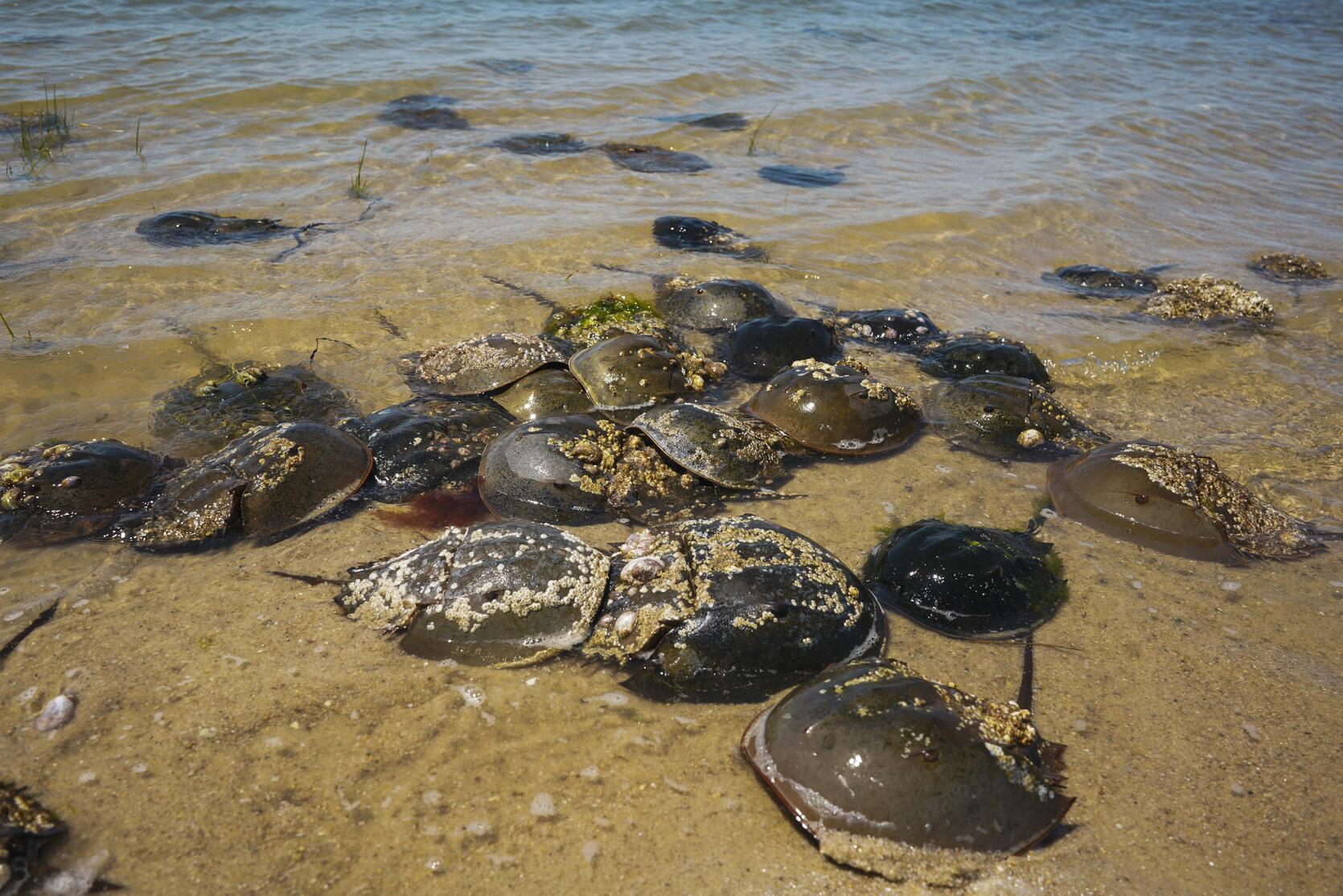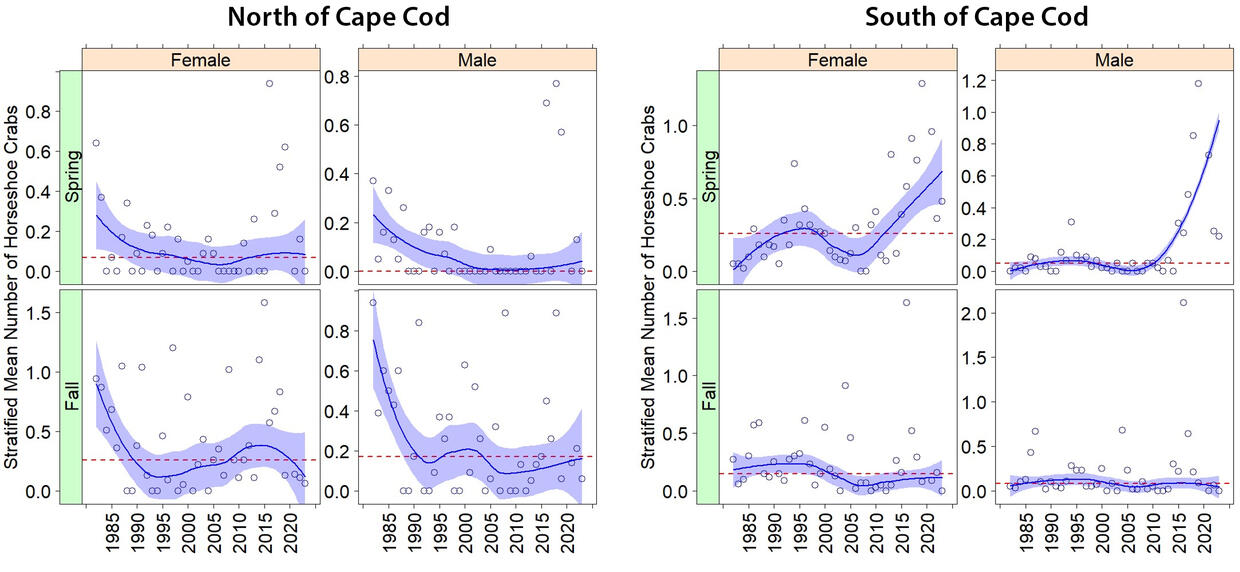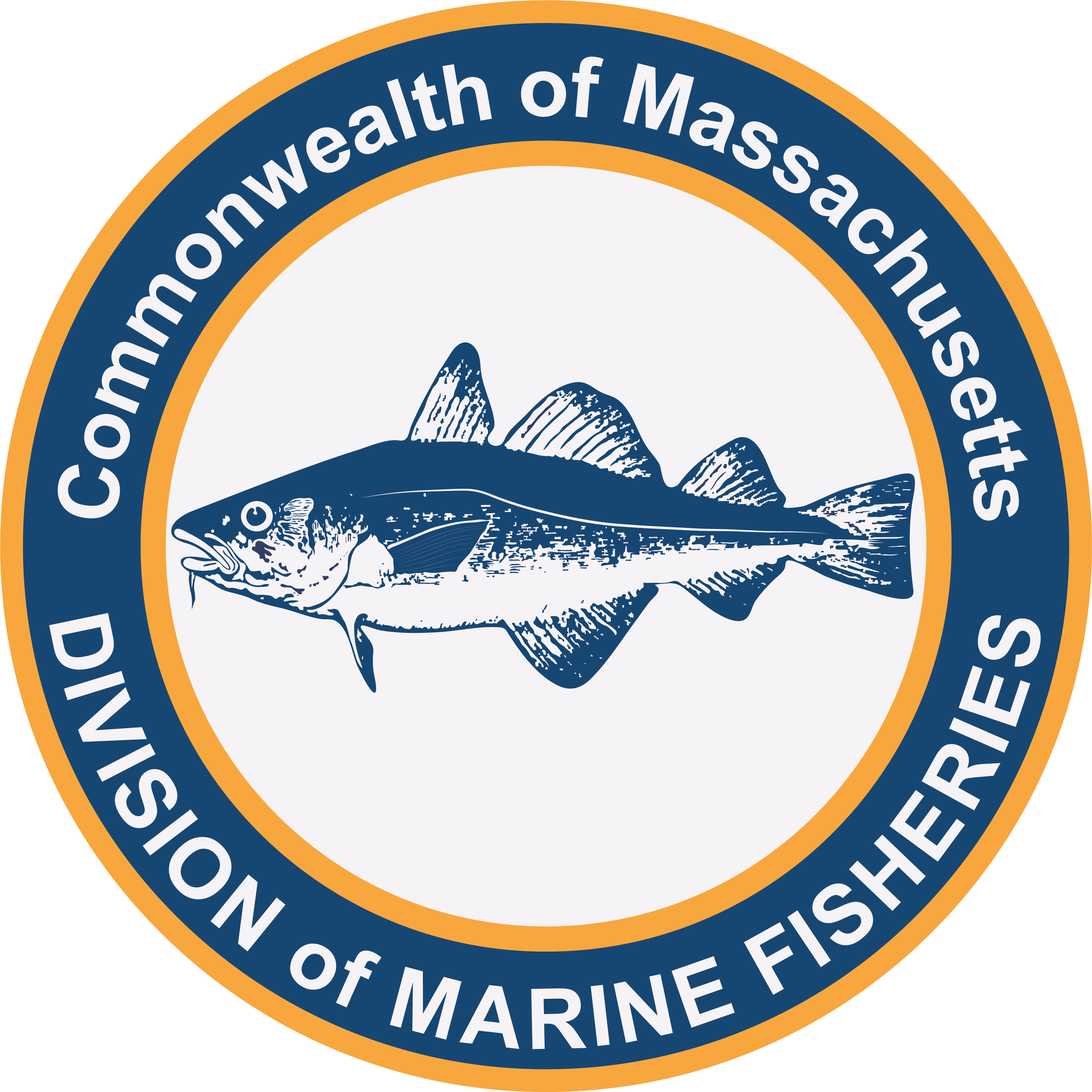- Division of Marine Fisheries

Beginning this year, spawning horseshoe crabs received the added protection of a continuous 7 ½ week no-harvest closure from mid-April through June 7. This new rule replaced the state’s intermittent 5-day “lunar closures” that surrounded each new and full moon in the spring. This proposal was supported by the Massachusetts Marine Fisheries Advisory Commission to enhance conservation by maximizing the spawning potential of the local populations. Based on data collected by DMF that describe the timing of spawning activity, this closure will protect about 90% of spawning crabs, allowing them to deposit eggs on Massachusetts beaches undisturbed. The greatest benefit of this new regulation will likely be observed on spawning beaches in about ten years, when the young crabs produced by this year’s eggs will return as mature adults to spawn.
The fishery is also managed by two quotas that we feel are conservative and sustainable: the quota for crabs harvested as bait is 140,000 crabs—far below the state’s 330,377 crab allowance in the interstate management plan; and the quota for crabs retained for biomedical purposes is 200,000 crabs, shared by the two licensed companies. This careful approach, including the newly adopted spawning closure, aligns with much of the public’s strong desire for this natural resource to be managed conservatively. While DMF has added the spawning closure to its management approach, it is important to recognize that Massachusetts horseshoe crab populations appear to be increasing in recent years. Nonetheless, DMF’s philosophy is to manage this species conservatively with precautionary management and rigorous oversight.
Horseshoe crabs have been around between 350 to 450 million years; they were here long before the dinosaurs and have been so successful that they have remained largely unchanged for millennia. Commercial horseshoe crab fisheries have existed since the 1800s when they were harvested by the millions in Delaware Bay for use as fertilizer. The use of horseshoe crabs as fertilizer declined in the early 1900s and ceased in the 1970s as other sources of fertilizer became more common. While the fertilizer fishery was mostly confined to Delaware Bay, two newer fisheries started in the 1970s along the east coast: a bait fishery, providing horseshoe crabs for use as bait in traps used to catch eels or whelk (also referred to locally as “conch”), and a biomedical fishery which collects crabs, draws a portion of their blood, then returns the crabs back to the sea. This blood is used to make Limulus amebocyte lysate, or LAL, which is used to test for bacterial contamination on or in products such as medical devices, insulin, vaccines, or anything else implanted or injected into the human body. The collection of horseshoe crab blood to make LAL started in Massachusetts, and the fishery has operated here for about 50 years, longer than anywhere else in the world. The harvest of crabs for biomedical use is regulated by DMF and harvesters and dealers are subject to many regulatory requirements to ensure the maximum survival of released crabs.
DMF has been confronted by a narrative circulated by some prominent conservation groups that horseshoe crab populations are declining in Massachusetts and are even at “historical lows.” However, this narrative is not supported by the data from surveys in Massachusetts. In fact, most data sources suggest the Massachusetts population is increasing, with some data sets at or near time series highs (see Horseshoe Crab Monitoring Results in Massachusetts below). Nor is it supported by the coastwide 2024 Horseshoe Crab Stock Assessment conducted by the Atlantic States Marine Fisheries Commission. This stock assessment, which was vetted by every state and federal horseshoe crab biologist from Massachusetts to Florida, shows that horseshoe crabs have increased coastwide, as well as in the Northeast region of Massachusetts-Rhode Island, since horseshoe crab fisheries management started in 1998.
DMF devotes substantial resources into monitoring horseshoe crab fisheries and populations in Massachusetts. DMF monitors the Massachusetts population of horseshoe crabs through three different surveys: spring and fall bottom trawl surveys; spring-time spawning beach surveys; and an annual beach seine survey. These surveys can have some substantial interannual variability in the results, so the assessment scientists focus on the long-term trends to assess the populations. Our biologists also collect data at the various stages of the fishery, at harvest and in the case of biomedical crabs, holding and release back to the water. DMF biologists have been going into biomedical facilities and bait markets since 2000 to monitor the size, sex, and condition of horseshoe crabs. Observation of the biomedical fishery increased in 2022, when a second biomedical firm opened in the state. Conservationists, concerned about the impacts of a second biomedical company, requested that DMF increase our biomedical sampling intensity. The biomedical industry also requested increased observation of their operations, due to their concerns over the spread of what they consider misinformation regarding their methods and the impact on crabs.
Eleven different DMF biologists collected data on nearly 12,000 horseshoe crabs during 51 commercial horseshoe crab sampling trips in 2023. The 51 sampling trips made the horseshoe crab fishery the second most observed fishery in the state, behind only the lobster fishery. DMF biologists collect commercial horseshoe crab fishery data aboard fishing vessels at-sea during harvest, at bait and biomedical dealers, at biomedical crab holding areas (e.g. pens), and at-sea aboard commercial vessels releasing biomedical crabs. DMF biologists found that only 1.5% of females and 1.0% of males died during the biomedical process from the time the crabs were caught until they were released; the remainder were successfully released alive. MA DMF is currently designing a study to look further into the long-term survival rates of biomedically bled—and released—crabs. We are committed to the sustainable management of this shared public resource.
By Derek Perry, Horseshoe Crab Biologist; Dr. Tracy Pugh, Invertebrate Fisheries Program Manager; and Dan McKiernan, Director
Horseshoe Crab Monitoring Results in Massachusetts
DMF Trawl Survey (Figure 1): This survey has a 46-year time series and covers state waters from the Rhode Island border to the New Hampshire border, which allows us to monitor long-term trends in horseshoe crab abundance in the state. Horseshoe crab abundance is generally higher south of the Cape than north, since Massachusetts is close to the northern extent of the species’ geographic range. Abundance trends over time are mixed, depending on region or survey season. In the northern region, survey trends are relatively flat in recent years except for slight downturns in the fall for females. In the southern region where population levels—as well as harvest rates—are higher, spring survey trends are positive for both sexes, while the fall survey results have been relatively stable in recent years.
DMF Horseshoe Crab Spawning Beach Survey (Table 1): This volunteer-based survey, conducted since 2008, monitors the number of spawning crabs at 16 survey beaches, mostly located on the Cape and Islands. The number of spawning females observed in the survey has increased at 72% of the beaches consistently surveyed over the last ten years. This survey is the best method we have for looking at changes in abundance in specific locations, such as in Pleasant Bay, Orleans, where horseshoe crabs have been harvested for biomedical purposes for about 50 years. While the spawning survey doesn’t go back that far, there is one site in Pleasant Bay that has been surveyed somewhat intermittently since 2001, first by a University of Rhode Island graduate student, and then by Mass Audubon as part of the Massachusetts Horseshoe Crab Spawning Survey. Over the period for which we have data, there is no evidence of a decline at this site; in fact, the last three years have been the highest data points in the time series. DMF is grateful for the time and effort put in by the following organizations who coordinate survey volunteers and collect Spawning Beach Survey data: Mass Audubon, North and South Rivers Watershed Association, Southeastern Massachusetts Pine Barrens Alliance, U.S. Fish and Wildlife Service, Maria Mitchell Association, Nantucket Conservation Foundation, and Erik Hunter.
DMF Seine Survey (Figure 2): This survey has consistently collected information on horseshoe crabs since 1984 and is conducted by DMF biologists in six embayments on the south side of Cape Cod from Falmouth to Chatham. Most of the crabs observed in this survey are found in Stage Harbor, Chatham. The survey has shown an increasing trend since the mid-2000s. The 2023 data point was the second highest of the time series.




